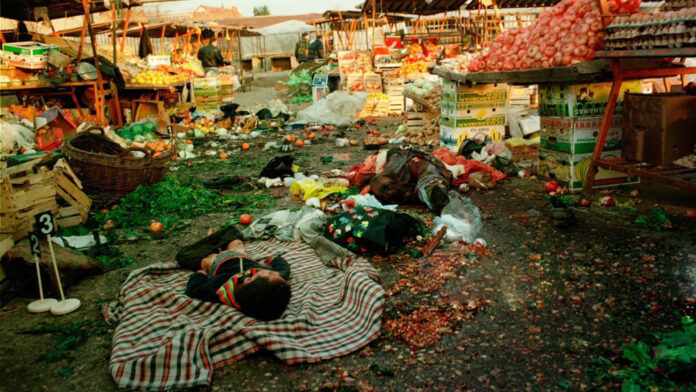The photograph taken by photographer Tyler Hicks in March 1999 shows the murdered five-year-old Roma Elizabeta Hasani
March 1999 was the month. More specifically, during a routine afternoon shopping in Mitrovica’s Green Market on March 13, 1999, a grenade thrown by members of Slobodan Milosevic’s regime detonated. This explosion claimed the lives of seven persons, six of them were Albanians and one was Roma. Six names—out of the seven people who perished as a result of this grenade—are listed on the commemoration plaque for this event, 20 years later. And they were Albanian, all six of them. Where is the name of the seventh victim’s name? The five-year-old Roma girl’s existence cannot be denied, even though the South Mitrovica municipality has refused to write her name or admit that the Serbian state killed her more than 20 years ago.
If Shkelzen Gashi, a publicist and civil society activist, hadn’t found out about this case and published it, neither you would be reading nor I would be writing this article.
He reacted to the case publicly by answering how you had discovered the non-inclusion of Elizabeta Hasani in the memorial plaque by saying, “While researching for photographs, I found a very significant photograph by the well-known photographer of the prestigious American newspaper, Tylor Hicks. A murdered woman can be seen there; there are probably three murdered female persons; and a five-year-old child can be seen. The child has short hair, and the New York Times says it’s a boy. However, it is not a boy; it is a girl. It is Elizabeta Hasani. I was also very worried why her name is not on the commemorative plaque that was erected by the Municipality of Mitrovica; without blaming the municipality anywhere, it could be a mistake; it could be completely unintentional,” Gashi told Radio Kosova in the program in the Romani language.
On the same occasion, Besa Ismaili, from the Commission for Human Rights in the Parliament of the Republic of Kosovo, as well as a member of the PDK, spoke, saying: “I don’t know the reasons why Elizabeta’s name was not included on the plate. But what is important is that Elizabeta’s name is said and remembered equally and dignifiedly, like all the others. We do not discriminate between victims. On the contrary, we honor them and condemn the aggressor who caused all these deaths. Of course, together with civil society activists, fellow citizens of Mitrovica, and fellow MPs, we will inform the institutions about the mistake they have made,” said Ismaili, who also comes from the city of Mitrovica.
Anyone who is asked about not including the five-year-old’s name on the plaque says that “it was a mistake.” We assume that this is the case, and if it really is, then why, in the Encyclopedic Dictionary of the Academy of Sciences and Arts of Kosovo, when this massacre is presented, only the six killed Albanians can be found?
This social scandal, which many institutional leaders are very quick to call a “mistake,” is neither the first nor the last “mistake” made on the cases concerning the crimes committed during the war against minority communities. As a general trend, the non-mention of war victims who did not meet the majority ethnic group with the largest number of victims from this war can be observed. The general narrative prevails that the citizens of ethnic minorities in Kosovo have helped the Serbian criminal regime commit the crimes and terror practiced on the territory of Kosovo during the last war. This also stands as the basis of not a little but evident discrimination that prevails in Kosovo against non-majority communities.

As an epilogue, this “mistake” was “corrected,” and Elizabeta’s name was written on the commemorative plaque of the so-called massacre of the green market in Mitrovica. However, even to this day, not much is said about her, and if it wasn’t for a coincidence like Shkëlzen Gashi’s research, we would never have known or heard about the existence or about the death of little Elizabeta. They killed her in March of ’99 physically, but we killed her for the second time, denying her existence in the first place. We refused to acknowledge and commemorate her passing as well as the fact that she had ever existed, thus not recognizing the fact that she was part of us and among us the day she was found walking in the market of her city, Mitrovica.
Little Elizabeta’s name was added to the memorial plaque following a public uproar that included emphasis from the foreign missions in Kosovo. What is known is that there are other cases like the one involving the five-year-old Roma girl, and that numerous crimes against the citizens of the Ashkali, Egyptian, Roma, and Bosnian communities in Kosovo have gone unreported and unaddressed. Neither political nor patriotic activism nor any other form of “humane” response has been observed in response to these atrocities. Their names should live on in the collective memory because they were and will always be human.
Written by: Hanmie Lohaj














